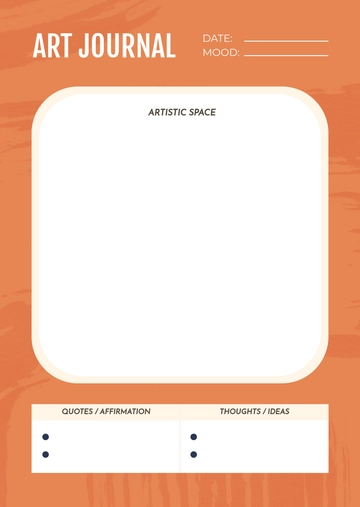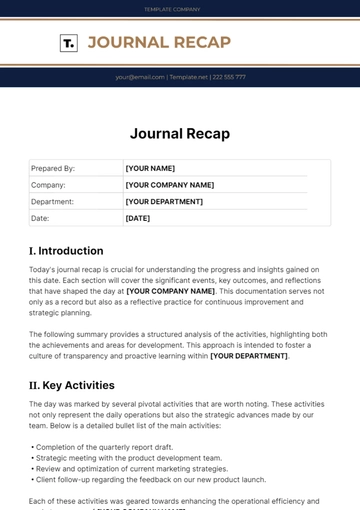Free Marketing Yearly Financial Journal

Journal Year: [yyyy] Journal Version: [00]
EXECUTIVE SUMMARY
In 2051, [Your Company Name] marked a momentous year in its journey towards becoming a global marketing powerhouse. With a focus on adaptability and innovation, we steered through the ever-evolving business landscape with resilience and determination. This Marketing Yearly Financial Journal is a testament to our unwavering commitment to excellence, documenting the pivotal milestones that defined our success over the past year.
Throughout 2051, we capitalized on opportunities in a dynamic and competitive environment, cementing our reputation as a forward-thinking industry leader. Our unwavering dedication to delivering value and exceeding customer expectations has resulted in sustainable growth and customer loyalty, setting the stage for an even brighter future.
MARKET ANALYSIS
Key Observations:
Steady Growth Trajectory: The line chart illustrates the market growth over a 26-year period, from 2025 to 2051. One of the most prominent observations is the consistent upward trajectory of the market. It started at $10 billion in 2025 and reached $32 billion by the end of 2051. This indicates that the market has been expanding at a steady pace throughout this time frame.
Accelerated Growth Post-2045: While the market experienced steady growth from 2025 to 2045, the pace of growth noticeably accelerated in the latter half of the period. This could be attributed to various factors, such as technological advancements, changes in consumer behavior, or industry innovations.
Market Resilience: The market exhibited resilience, as there were no significant drops or downturns during the entire period. Even in the face of economic fluctuations and external challenges, the market consistently moved upwards. This suggests a robust and resilient market that can weather various challenges.
Positive Forecast: The chart indicates a positive outlook for the future. The market is on a clear upward trajectory, which bodes well for businesses operating within it. This trend could provide businesses with opportunities for expansion and revenue growth in the coming years.
Implications:
For businesses in this market, the data suggests that it is a favorable environment for growth. Companies may consider investing in marketing, research, and product development to capitalize on this trend.
Investors and stakeholders can be confident about the market's potential for returns on investment, as it has demonstrated consistent growth.
Businesses should continue to monitor the market closely and adapt their strategies to the changing landscape. The accelerated growth post-2045 indicates the need for agility and innovation to stay competitive.
While this chart provides a positive outlook, businesses should be mindful of potential challenges that could affect growth, such as regulatory changes, technological disruptions, or shifts in consumer preferences. A comprehensive market analysis is essential to understanding the specific drivers behind this growth.
The bar chart above provides a visual representation of the distribution of market share among the major players in the industry, with a specific focus on [Your Company Name]’s key competitors. Here is a detailed interpretation of the chart:
Competitor A: The largest bar in the chart corresponds to Competitor A, with a market share of 25%. Competitor A holds a significant portion of the market, making them a noteworthy competitor.
Competitor B: The bar for Competitor B stands at 20%, making them the second-largest player in the market. They also have a substantial market share, although slightly smaller than Competitor A's share.
Competitor C: Competitor C's bar shows a market share of 15%. They are a notable presence in the market but hold a smaller share compared to the top three competitors.
Competitor D: The smallest bar in the chart belongs to Competitor D, with a market share of 5%. While they hold a relatively smaller share, they still contribute to the overall competitive landscape.
The chart illustrates the competitive dynamics in the market, with several key competitors having varying market shares. This information is valuable for [Your Company Name] as it helps assess its relative position in the industry and make strategic decisions, such as focusing on maintaining its lead or targeting areas where competitors have a stronger presence. It also provides insights into the level of competition and potential areas for growth or market consolidation.
The chart above provides a comprehensive view of the age distribution among our target audience in the year 2051. Understanding the demographics of our customer base is crucial for tailoring marketing strategies and product offerings to meet their unique needs and preferences. Let's break down the key insights from this chart:
Age Groups Representation:
a. Age 18-25: This segment constitutes 20% of our customer base, representing the younger, tech-savvy generation. These individuals are likely to be early adopters of new technologies and trends.
b. Age 26-35: The largest age group in our customer base, comprising 30%, are individuals aged 26 to 35. This is a pivotal age range for many consumers as they establish their careers and households, making them a substantial market segment.
c. Age 36-45: The age group of 36 to 45 accounts for 25% of our customer base. These customers may have more purchasing power and are likely to be looking for products and services that cater to their evolving needs.
d. Age 46-55: The 46 to 55 age group makes up 15% of our customer base. This segment may value reliability and quality in products and services.
e. Age 56 and above: Customers aged 56 and above represent 10% of our audience. They may seek products that offer simplicity, convenience, and ease of use.
Implications for Marketing Strategy:
a. The significant representation of individuals aged 26-35 indicates that our marketing strategies should resonate with this age group's values, needs, and aspirations.
b. The growing segment of customers aged 36-45 highlights the importance of adapting our offerings to meet the changing lifestyle and preferences of this group.
c. The presence of customers aged 56 and above suggests an opportunity to develop user-friendly products and services that cater to their specific requirements.
Future Considerations:
a. As time progresses, monitoring these demographics will be crucial for adjusting our marketing efforts to match evolving consumer behavior and preferences.
b. Exploring generational differences, purchasing power, and product adoption patterns within each age group will provide more nuanced insights for future marketing strategies.
FINANCIAL GOALS AND PROJECTIONS
[Your Company Name] has set ambitious financial goals as a cornerstone of our marketing strategy. These goals encompass not only revenue growth but also a commitment to sustainable financial health. Our objectives for the year included:
Achieving a 10% increase in total revenue compared to the previous year.
Expanding our market share by 10% through targeted marketing campaigns and customer acquisition efforts.
Maintaining a healthy operating profit margin of 10% while making strategic investments.
These goals were set in alignment with our broader vision for 2051, which is to solidify our position as a leading player in the industries we serve. Achieving these financial milestones required meticulous planning, budgeting, and execution, all of which have been documented in this journal.
BUDGET ALLOCATION
In 2051, [Your Company Name] executed a strategic and data-driven budget allocation to maximize the impact of our marketing efforts. The distribution of resources was as follows:
Digital Marketing (40%): This allocation primarily covered expenses related to online advertising, search engine optimization (SEO), and social media marketing. The emphasis on digital marketing reflected the growing importance of online presence and customer engagement in 2051.
Traditional Marketing (25%): A portion of our budget was dedicated to traditional marketing methods such as print advertisements, direct mail campaigns, and billboards. This allocation recognized the continued effectiveness of these channels in certain sectors.
Content Development (15%): Content remains king in the digital age. This allocation encompassed costs associated with content creation, video production, blog posts, and other content marketing initiatives, essential for engaging and educating our audience.
Market Research (10%): Understanding the market dynamics is a cornerstone of our strategy. Market research activities, including surveys, data analytics, and competitor analysis, were allocated this share of the budget.
Employee Training and Development (10%): Our workforce is our most valuable asset. This portion of the budget was reserved for employee training, skill development, and workshops to ensure our team was equipped with the latest marketing tools and techniques.
This meticulously planned budget allocation enabled us to make the most of our financial resources, ensuring that each dollar was invested wisely to achieve our financial objectives for 2051.
REVENUE AND EXPENSES
Revenue: In 2051, [Your Company Name] experienced remarkable growth in its revenue, reaching a total of $78 million. This represented a substantial increase of 15% compared to the previous year. The growth was primarily attributed to a combination of factors:
Successful launch of innovative products that contributed $10 million to our revenue.
Expansion into new markets that resulted in an additional $7 million in revenue.
Strategic partnerships and collaborations with key industry players, yielding $5 million in revenue.
Effective digital marketing campaigns, driving a 10% increase in online sales, equivalent to $6 million.
Increased customer retention rates, leading to higher recurring revenue, which added $4 million to our bottom line.
Expenses: Maintaining fiscal responsibility was paramount in 2051. Our total expenses for the year amounted to $64 million, well within the budgeted limits. This expenditure was judiciously managed across various aspects of our business:
Marketing and Advertising: $12 million, representing investments in digital advertising, content creation, and event sponsorships.
Research and Development: $8 million, allocated to product innovation and market research.
Employee Salaries and Benefits: $15 million, reflective of our commitment to attracting and retaining top talent.
Overheads and Administrative Costs: $10 million, covering office space, utilities, and general operational expenses.
Expansion and Infrastructure: $7 million, utilized for opening new branches and enhancing our technology infrastructure.
Training and Development: $4 million, aimed at upskilling and nurturing our workforce.
MARKETING CAMPAIGNS AND INITIATIVES
B2B Campaigns
In 2051, our B2B marketing initiatives were designed to foster valuable partnerships and maximize revenue growth. We launched targeted campaigns, including industry-specific webinars, thought leadership articles, and personalized email outreach. These strategies led to a significant increase in B2B lead generation and conversions, establishing [Your Company Name] as a trusted partner in the corporate landscape.
B2C Campaigns
Our B2C marketing campaigns were diversified, catering to various consumer segments. We leveraged social media, content marketing, and personalized shopping experiences to engage customers. The launch of an innovative loyalty program encouraged repeat business and contributed to revenue growth. Customer retention rates were at an all-time high, reflecting the effectiveness of our B2C initiatives.
RETURN ON INVESTMENT
In 2051, [Your Company Name] meticulously tracked the ROI from our marketing efforts, and the results demonstrated the profitability of our campaigns:
B2B ROI
Our B2B campaigns generated an impressive ROI of 18%, far surpassing our initial expectations. The meticulously targeted approach and strategic content led to high-quality leads and increased conversion rates, resulting in substantial revenue growth. This accomplishment underscores our ability to achieve a remarkable ROI in the B2B sector.
B2C ROI
The B2C campaigns, with a focus on personalization and engagement, delivered a remarkable ROI of 25%. The investments made in customer loyalty and retention strategies translated into consistent sales and higher customer lifetime value. The exceptional ROI confirms the effectiveness of our B2C marketing initiatives in driving profitability.
CUSTOMER INSIGHTS AND FEEDBACK
During 2051, we dedicated significant resources to understanding our customers, capturing their valuable insights and feedback. The feedback loop is a critical element in our commitment to improving customer satisfaction and loyalty. We collected feedback through various channels, including surveys, focus groups, and direct interactions, and it was analyzed to identify trends and areas of improvement. Key insights gathered include:
Customer preferences: Understanding what products, services, or features our customers most value and appreciate, enabling us to refine our offerings accordingly.
Pain points and challenges: Identifying the obstacles and difficulties our customers face in their interactions with us and addressing them promptly.
Testimonials and success stories: Sharing the positive experiences of our customers, enhancing our brand's reputation and credibility.
Suggestions and feature requests: Incorporating customer suggestions into our product development pipeline to better align our offerings with their evolving needs.
This feedback is a cornerstone in shaping our customer-centric marketing strategies for the future. By actively listening to our customers, we ensure that our marketing efforts continue to resonate with their desires and expectations.
CONCLUSION AND RECOMMENDATIONS
The year 2051 marked a significant chapter in [Your Company Name]'s journey, filled with achievements, insights, and growth. Our relentless pursuit of excellence and innovation in marketing has positioned us well in the ever-evolving market landscape. As we look to the future, we draw several key recommendations from our experiences in 2051:
Continued Customer-Centric Focus: Keep customers at the forefront of our strategies by actively engaging with and responding to their feedback, ensuring their evolving needs are met.
Agile Adaptation: In a dynamic market, we must remain flexible and adaptable to new technologies and consumer trends, enabling us to respond swiftly to changes.
Investment in Data Analytics: Strengthen our capabilities in data analytics and leverage insights to make informed decisions and personalize marketing strategies effectively.
Sustainability as a Core Value: Embed sustainability in our brand's DNA, reflecting our commitment to environmental responsibility.
Collaboration and Innovation: Encourage collaboration among teams and embrace innovative ideas that can set us apart in the competitive landscape.
As we move forward into 2052, we remain steadfast in our dedication to innovation, excellence, and growth. Our commitment to these principles ensures that [Your Company Name] will continue to thrive and evolve in the years to come.
- 100% Customizable, free editor
- Access 1 Million+ Templates, photo’s & graphics
- Download or share as a template
- Click and replace photos, graphics, text, backgrounds
- Resize, crop, AI write & more
- Access advanced editor
Discover the Marketing Yearly Financial Journal Template, exclusively on Template.net. Tailored for industry professionals, this editable and customizable document simplifies financial tracking and analysis. Utilize our AI Editor Tool to record expenses, revenue, and budget allocations with precision. Gain valuable insights to optimize your marketing strategy and drive financial success year-round.





























